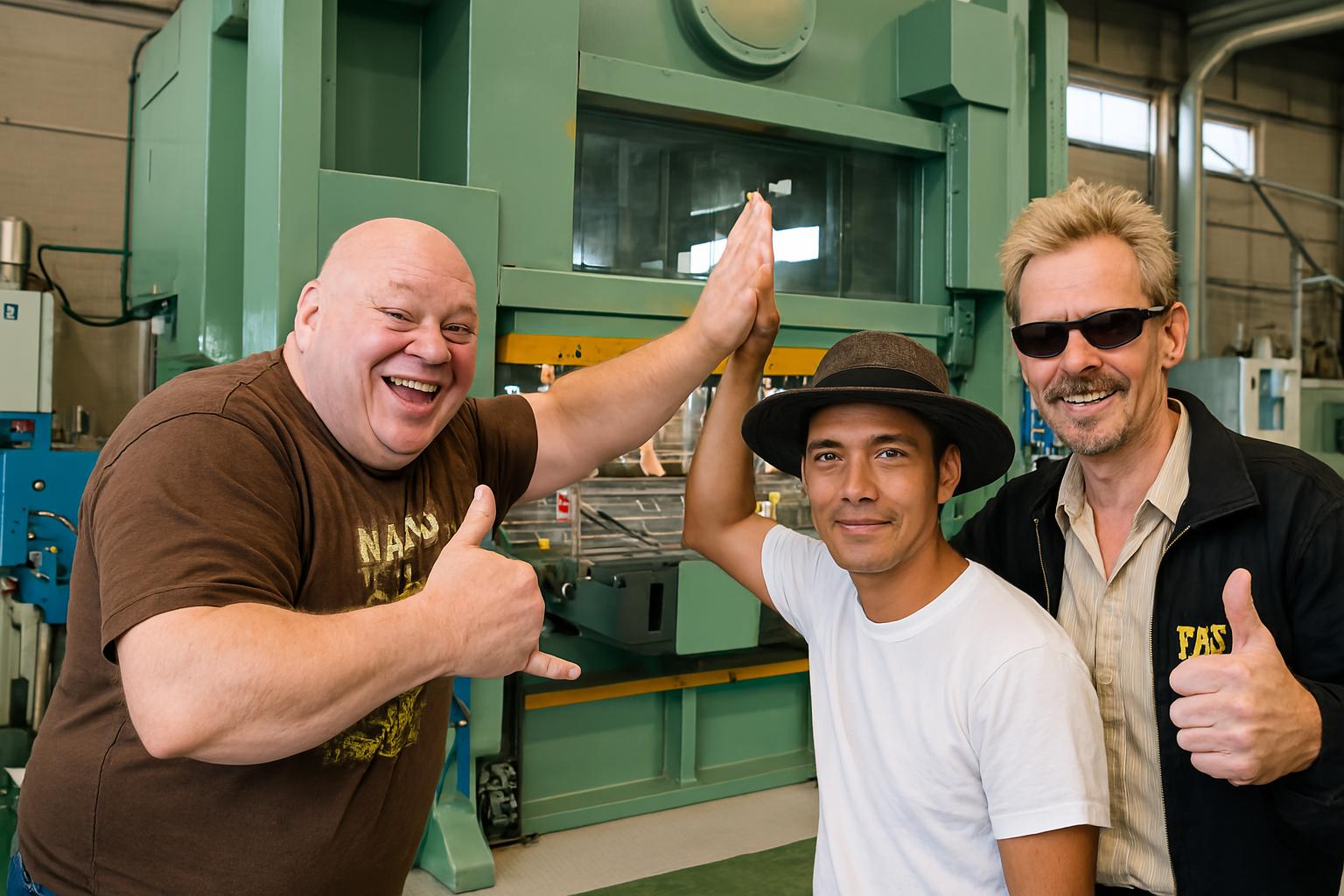日本からケンタッキーへ──ひとつのプレス、一発のパンチ、そして数々の学び。
2005年。俺は日本からアメリカ・ケンタッキー州フランクフォートの工場に派遣された。
ミッションはただひとつ:重大な不良を直せ。
現地で製造されていたのは、シートアジャスタの部品。
車の座席がガタガタ揺れるうえに、リクライニングがうまく動かないという厄介な症状が出ていた。
現地のスタッフ曰く、問題は部品形状にあるらしい。
ブラケットとレールが一体化したスマートな設計。
でも、プレスを打つたびに曲げ角が甘くなっていき、曲げ位置もズレて、
U字曲げの底がアーチ状に変形していた。
で、それを車に取り付けたら――まあ、大騒ぎになるわけだ。
しかも、問題は1つや2つじゃなかった。
6箇所同時に不具合が出ていた。
しかも、これらの部品を作る金型は日本製じゃない。
現地・フランクフォート工場製の金型だったんだ。
日本ではU曲げを最後の工程で「切ってから曲げる」“切曲げ”方式で行っていた。
しっかり底突きが効いてて、反りがなく、面もバシッと出てた。
なぜか?その底面が摺動面だからだよ。超重要。
一方、アメリカ製の金型は2段階の曲げ工程。
しかも反りが出やすいウェッブ面を底突きせずに済ませてた。
いろんな対策を講じたらしいが、どれも不発。
そして、俺に白羽の矢が立った。
当時の俺は、金型設計の専門家ってわけじゃなかった。
ファインブランキングや単発型の経験はあったけど、設計や構造には自信がなかった。
でも、派遣されたのは俺だけ。単身乗り込みだ。
アメリカに着いて早々、
いきなり本部長にブチギレられた。
「早く直せってんだよォ!」
初日。異国。英語も通じねぇ。何が何だかわかんねぇ。
現地のスタッフに話しかけても完全無視。
もうメンタルはボッコボコ。
夜、ホテルに戻るなり、英語の勉強を始めた。
リアルなフレーズをメモに書き出して、次の日のシュチュエーションを想定しながら、
「この場面ではこれを言う!」って自分に叩き込んだ。
翌朝、会社に行ったら…なんだこりゃ!?
1000トンプレスのラインで大トラブルが発生してた。
体重200キロのヤンキー大男と、
ちょっと痩せてるけど俺よりもずっとデカい奴がアタフタしてる。
「ここだ!」
俺は覚えたばかりの英語を使った。
「Can I help you?(何か手伝おうか?)」
彼らはすぐさま勢いよく状況を説明してきた。
まあ…半分もわかんなかったけど、なんとなく感覚で原因が読めた。
手を入れて直したら、見事にビンゴ。
そしたら大男が笑顔でハイタッチしてくれて、
叫んだ一言。
「HEY! ケニ!」
その瞬間から俺はただの「変なアジア人」じゃなくなった。
俺は“ケニ”になったんだ。
そして、現地のスタッフも少しずつ心を開いてくれるようになった。
さて、本命の金型の話に戻ろう。
このアメリカ製金型はかなりややこしい構造だった。
- 曲げ2段階
- リストライク(再成形)工程
- 2回目の曲げはカムで押す方式
長尺のシートアジャスタだから、理論上は理にかなってる。
カムのスプリングも正常。
金型自体の破損もない。
それでも、なぜか直らねぇ。
時間だけが虚しく過ぎていったある日、
俺は上型のストリッパーを外してみた。
そこで目に飛び込んできたのが…
スプリングの位置が、曲げ箇所からズレてる!
一番押さえが必要なところに、力がかかってねぇ!
しかもストリッパー自体、プリハードン鋼で焼き入れなし。
見た目はペラペラ、2枚重ねのヘナヘナ構造。
俺は叫んだ。
「これだッ!!」
現地のスタッフに説明したら、最初は半信半疑。
でも「とりあえずやってみよう」って話になった。
🔧 そして改修へ:
- 曲げの真上にガスクッションを複数配置
- 既存のコイルスプリングも強化
- ホルダーを削ってたわみ代を確保
- パンチプレート(焼き入れ材)を超大型で追加工
正直、骨の折れる大工事だった。
そして、ついにやってきた。
1000トンプレスでのトライ。
加工品が出てきた――
寸法、バッチリ。
そして、現場中が湧いた。
「Damn, Keni! You’re a genius!(おいケニ、天才じゃねぇか!)」
「Holy crap, it actually worked!(マジで直っちまったぞ!)」
「Keni, you’re the man!(ケニ、お前最高だよ!)」
ハイタッチが飛び交い、笑いが起き、
工場中に歓声が響いた。
あのときの達成感。
一生忘れねぇ。
ケニの学び
コイルスプリングもガスクッションも、
「ただ入れてりゃいいってもんじゃねぇ」。
どこに、いつ、どの方向で効かせるか。
それがすべてだ。
今回みたいに、捨て曲げがないと材料が引っ張られて、
小さな押さえ不足が反りの原因になる。
しかもこの不具合、最初から潜んでたんだ。
材料ロットの違い、スプリングのへたり、ストリッパーのコンディション…
それらが少しずつ積もって、ついに爆発した。
最後に
俺は“答え”を見つけたんじゃねぇ。
“声”を聞いたんだ。
鉄と材料が、小さく、でも確かに、叫んでいた。
その声に耳をすました。
だからこそ、問題は解決できたんだ。
“Solving Seat Adjuster Warpage – Keni’s Frankfort Die-Hard Story”From Japan to Kentucky, one press, one punch, and a whole lotta learning.
In 2005, I was sent from Japan to a factory in Frankfort, Kentucky.
My mission: Fix a critical defect in the seat adjuster parts they were making.
These parts were causing serious vibration while driving, and the adjuster mechanism wasn’t working properly.
According to the local team, the problem was in the part’s shape.
The bracket and rail were integrated into one smart design.
But with each press stroke, the bending angle got weaker, the bend position started shifting,
and the U-shaped base turned into a damn arc.
When mounted in the car, it caused all kinds of chaos.
And it wasn’t just one issue—we had about six different defects happening at the same time.
Worse, these parts weren’t made using Japanese dies.
Nope—these dies were made locally in Frankfort.
Back in Japan, the U-bend was done as a final “cut-bend” process,
with a solid bottom stop, minimal warp, and clean flatness.
Why? Because that base was the sliding surface—super important.
But the US-made die used two-stage bending.
The structure caused warping on the web and flange sides, and they weren’t bottomed out properly.
The team tried all sorts of fixes—but nothing worked.
And that’s when they called me in.
At that time, I wasn’t a die design expert.
I had experience with fine blanking and single-hit dies,
but I was more involved with machining and parts procurement.
Still, I was the guy they sent. Alone.
I arrived in America and BAM—
The Japanese general manager yelled,
“Fix it fast, dammit!”
Day one. Different country. Different language. No clue what was going on.
I tried talking to the American staff.
They ignored me completely. Didn’t understand me. Didn’t want to.
I felt crushed.
That night, I went straight to my room and started studying English.
Real phrases. Work-related scenarios.
I imagined what might happen the next day and memorized what I’d say.
The next morning, I saw a scene right out of a movie—
The 1000-ton press area was in chaos.
A 200-kilo Yankee giant and his skinnier-but-still-huge partner were clearly in trouble.
I saw my chance.
Walked up and said:
“Can I help you?” — my first real line of English.
They started talking—fast, loud, full of slang—but I caught the gist.
I took a shot, fixed the issue, and BOOM, it worked.
The big guy slapped my hand for a high-five and yelled:
“HEY! KENI!”
From that moment, I wasn’t just “some Japanese dude.”
I was Keni.
And things started changing.
Even the die guys started opening up.
Now, about that die…
It was a complex American design:
- Two-stage bending
- A re-strike step
- And the second bend used a cam system.
For a long seat adjuster, it made sense… in theory.
The cam spring was fine.
No damage to the die.
But still—something was off.
Days passed. No answers.
Then one day, I took off the upper stripper plate and finally saw it:
The springs were way off position.
They weren’t pushing where the material really needed to be held during bending.
Plus, the stripper was made from pre-hardened steel, no heat treatment.
It had a weak double-plate structure. Honestly, it looked like a pancake.
That’s it! That’s the damn cause!
I explained it to the local staff.
They looked skeptical, but they agreed to try my fix.
🔧 The Fix:
- Added gas springs right above the bend.
- Reinforced the existing coil springs.
- Shaved down the holders to allow deflection.
- Re-machined massive, heat-treated punch plates.
A serious overhaul. A real workout.
Then came the big day:
1000-ton press trial.
Out came the part…
Perfect.
The measurement? Spot on.
And then it started:
“Damn, Keni! You’re a genius!”
“Holy crap, it actually worked!”
“Keni, you’re the man!”
High fives everywhere.
I’ll never forget that feeling.
What I Learned:
You can throw all the springs and cushions you want in a die—
But if they’re not where the force is needed,
they’re useless.
In this case, there was no escape bend on the other side,
so the material was dragged, pulled, twisted.
This problem had always been there, even from the first die trial.
But slowly—spring wear, material variation, surface changes—
It crossed the line and became a full-blown disaster.
Final Words
I didn’t find the “answer.”
I just listened—to the steel, to the tool, to the part.
Because sometimes…
the metal screams before it breaks.
You just have to hear it.


